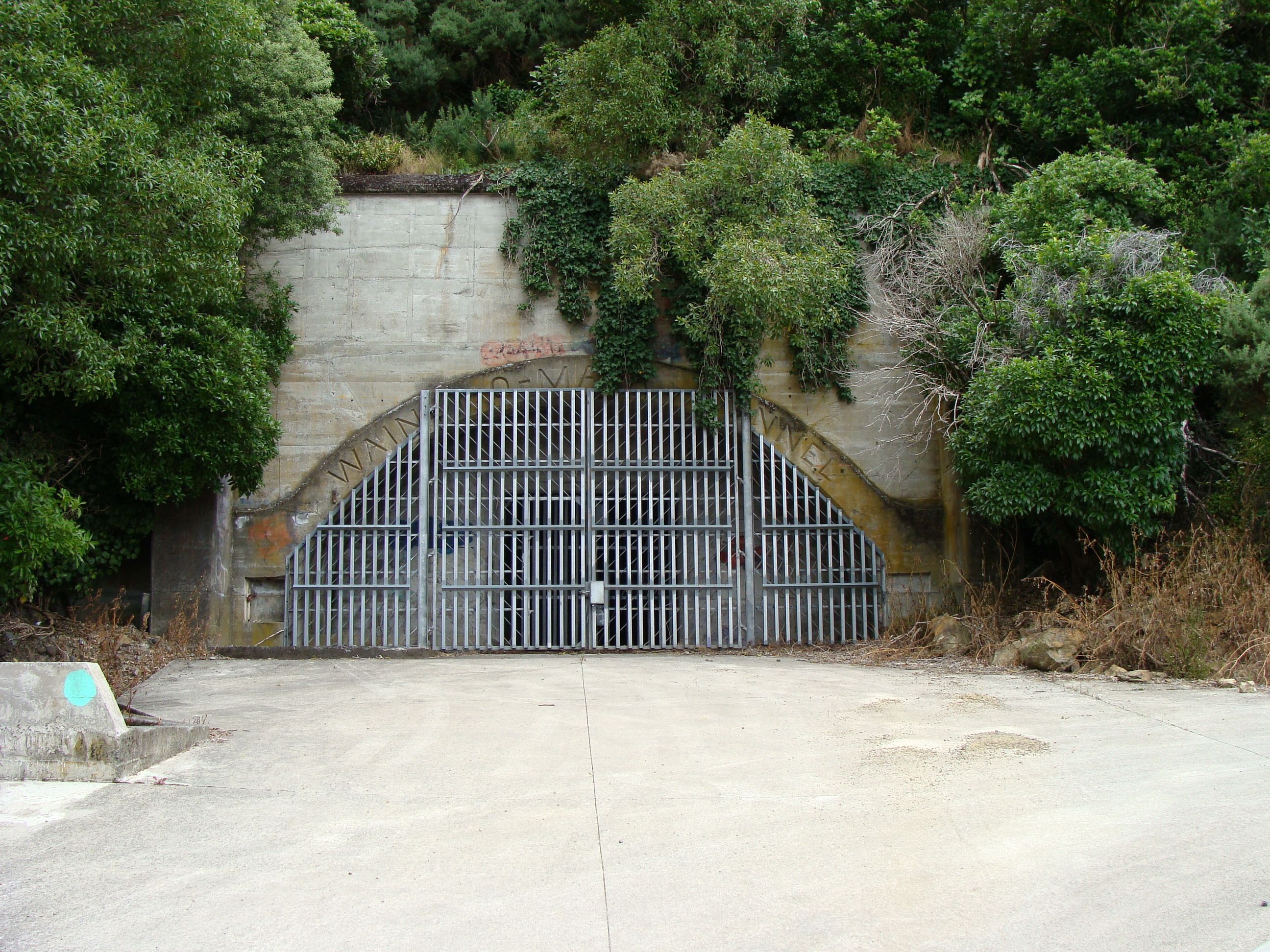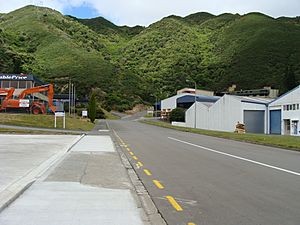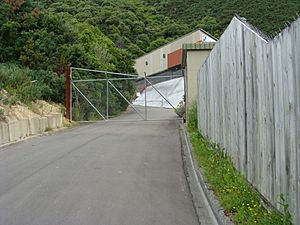Wainuiomata Tunnel facts for kids
 |
|
| Hutt Valley portal of the Wainuiomata Tunnel | |
| Overview | |
|---|---|
| Location | Lower Hutt, Wellington, New Zealand |
| Coordinates | 41°14′49.53″S 174°55′26.08″E / 41.2470917°S 174.9239111°E |
| Status | abandoned as road tunnel, converted to utility tunnel |
| Start | Tunnel Grove, Gracefield, Lower Hutt |
| End | Waiu Street, Wainuiomata, Lower Hutt |
| Operation | |
| Work begun | January 25, 1932 |
| Owner | Greater Wellington Regional Council |
| Traffic | pedestrian/cyclist and automotive (planned) |
| Character | road (planned); utility (current) |
| Technical | |
| Number of lanes | 2 (planned) |
| Highest elevation | 100 metres (328 ft) |
| Lowest elevation | 34 metres (112 ft) |
| Tunnel clearance | 16 feet (4.9 m) |
| Width | 25 feet 6 inches (7.77 m) |
| Grade | 1 in 15 |
The Wainuiomata Tunnel was planned to make it easier to get to the Wainuiomata Valley in the Wellington Region of New Zealand. This was part of a big plan in the 1930s to build new homes there. Work on the tunnel started in 1932. However, it stopped a few years later because there wasn't enough money. This was due to a time called the Great Depression, when the economy was very bad.
The tunnel was never used for cars or trucks. It was mostly unused, except for a short time during World War II. Later, in 1975, it was sold and finished as a utility tunnel. This means it now carries important pipes and cables, like water pipes.
Contents
History of the Wainuiomata Tunnel
Why Was the Tunnel Needed?
A company called Wainui-o-Mata Development Limited was created to build up the Wainuiomata Valley. Their goal was to buy land, divide it into smaller pieces, and sell them for houses. A very important part of this project was building a tunnel. This tunnel would connect the Hutt Valley and Wainuiomata Valley. It would make it much easier for people to reach the new homes.
Planning the Tunnel's Design
The Wainuiomata Tunnel was designed to be like the Mount Victoria Tunnel in Wellington. It was meant to have two lanes for cars going in opposite directions. There was also a raised path for people walking on one side.
The tunnel would start near an industrial area called Gracefield. It would then go uphill at a steep angle to reach the hills in Wainuiomata. It was planned to be about 8 meters wide and 5.5 meters high. The walking path would be about 1.2 meters wide.
The New Zealand Railways Department was very interested in the tunnel. They wanted to use it for their own transport services. In 1928, they made a deal with the development company. This deal gave them the only right to run "motor or electrical passenger transportation" through the tunnel. This included buses or even electric trams.
The company promised to make the tunnel wide enough for two buses to pass. They also agreed to provide land for bus stops in Wainuiomata. The Railways Department would start bus services once 50 families lived in the valley.
In October 1931, the company asked for bids to build the tunnel. They chose Templeton Tunnel Construction Company for the job.
Building the Tunnel
Work began on January 25, 1932. Many workers were hired through a special program. This program helped people find jobs during the economic depression. A camp was set up for the workers. Buildings for workshops and power were built near the tunnel entrance.
Large machines were brought in. These included electric motors for air compressors and ventilation. They also had equipment to put concrete on the tunnel walls.
Unlike most tunnels, this one was dug only from one end. Workers started from the western end, digging towards Wainuiomata. This was done to help with drainage. The tunnel was on a steep slope, so water could flow out naturally. If they had dug from the other end, they would have needed to pump the water out.
The workers found that the ground was difficult to dig through. It was often soft earth or "rotten" rock. This made the work harder.
Work continued steadily in the early 1930s. However, the development company relied on selling land to fund the tunnel. The economic depression meant fewer people were buying land. Because of this, the company ran out of money. In 1936, they stopped work on the tunnel. About one-third of the tunnel was completed, and most of that was lined with concrete.
The Tunnel During World War II
In 1942, the New Zealand Army wanted to use the tunnel. They planned to store explosives there. It could also be used as an air raid shelter. The Army leased the tunnel from the development company. The lease lasted for the rest of the war plus six months.
The Army made changes to the tunnel to prepare it for storage. They installed electric lights and improved the drainage. A security fence was put up around the entrance. They also leveled the ground inside the tunnel. This made it easier to stack explosives. A loading dock was built for trucks. The Army took over the completed storage area in June 1942.
The Army decided to leave the tunnel early. They moved out all their supplies and finished restoring the site by February 1945.
Hopes for Finishing the Tunnel
After construction stopped in the 1930s, people still hoped the tunnel would be finished. This hope continued into the 1950s, especially after new houses started being built in Wainuiomata in 1941.
Around 1956, a meeting was held to discuss the tunnel's future. Experts agreed that the tunnel, as it was, was not suitable for modern cars or trains. It was too narrow for today's traffic. It was estimated that it would cost a lot of money to finish it properly. This would likely mean making the tunnel wider.
During the 1963 general election, a politician named Michael Moohan said the idea of finishing the tunnel was "a dead duck." He explained that it was too narrow for modern traffic and too steep for a train.
The Tunnel Becomes a Water Pipe
By the 1970s, an old water pipe in another tunnel needed to be replaced. The Wellington Regional Water Board bought the Wainuiomata Tunnel in 1975. They planned to use it for a much larger water pipe. Some people were against this idea. They worried it would stop the tunnel from ever being finished for cars.
A company called Codelfa Construction NZ Limited was hired to complete the tunnel. They started work in early 1980. They finished the section of the tunnel to a smaller width of about 2.4 meters.
The Tunnel Today
Today, the Greater Wellington Regional Council is in charge of the tunnel. They also look after the water supply pipe inside it. The tunnel now carries a sewer pipeline and telecommunications cables too.
In the 1990s, the Hutt City Council wanted to build a new wastewater treatment plant. They tried to use the Wainuiomata Tunnel for a sewer pipe. Since that wasn't possible at the time, they used the smaller, older Waiwhetu Tunnel instead. Later, in 2001, the Regional Council and Hutt City Council agreed. The Hutt City Council could then use the Wainuiomata Tunnel to install their sewer pipe.
The tunnel is sometimes opened to the public for special tours.






